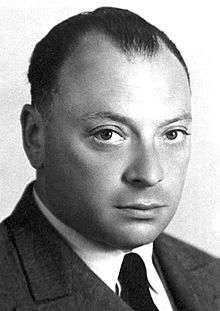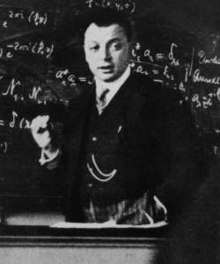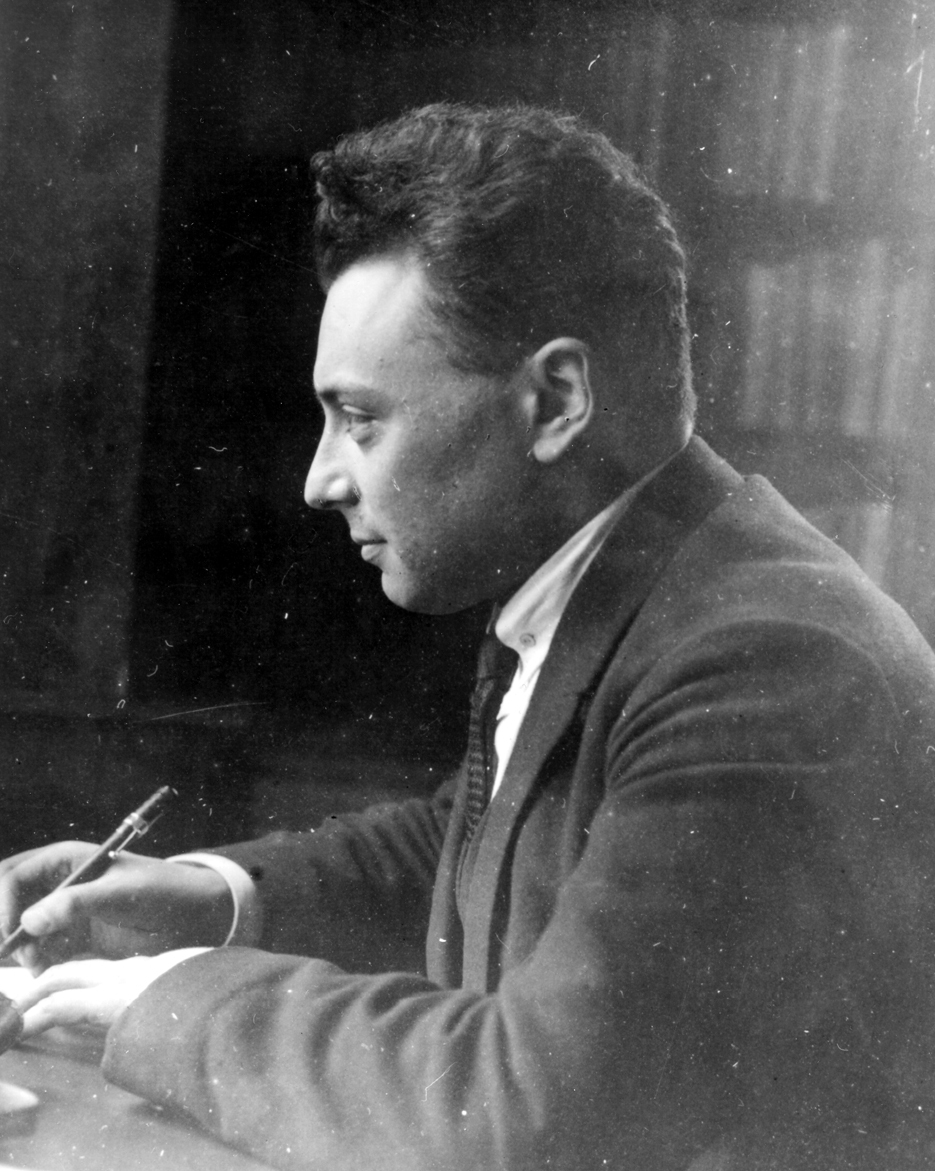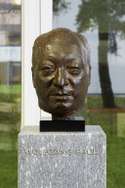Wolfgang Pauli
Wolfgang Ernst Pauli (/ˈpɔːli/;[5] German: [ˈvɔlfɡaŋ ˈpaʊli]; 25 April 1900 – 15 December 1958) was an Austrian theoretical physicist and one of the pioneers of quantum physics. Later in life he got the citizenships of the United States and Switzerland. In 1945, after having been nominated by Albert Einstein,[6] Pauli received the Nobel Prize in Physics for his "decisive contribution through his discovery of a new law of Nature, the exclusion principle or Pauli principle". The discovery involved spin theory, which is the basis of a theory of the structure of matter. He also showed a precocious ability for physics getting his PhD at age 21 even though he graduated high school at 18 (about average age for graduation).
Wolfgang Ernst Pauli | |
|---|---|
 | |
| Born | Wolfgang Ernst Pauli 25 April 1900 |
| Died | 15 December 1958 (aged 58) Zurich, Switzerland |
| Citizenship | Austria United States Switzerland |
| Alma mater | Ludwig-Maximilians University |
| Known for | |
| Awards |
|
| Scientific career | |
| Fields | Theoretical physics |
| Institutions | University of Göttingen University of Copenhagen University of Hamburg ETH Zurich Institute for Advanced Study |
| Thesis | About the Hydrogen Molecular Ion Model[3] (1921) |
| Doctoral advisor | Arnold Sommerfeld[3][2] |
| Other academic advisors | Max Born |
| Doctoral students | |
| Other notable students | |
| Influences | |
| Influenced | Ralph Kronig |
| Notes | |
His godfather was Ernst Mach. He is not to be confused with Wolfgang Paul, who called Pauli his "imaginary part",[4] a pun with the imaginary unit i. | |
Biography
Early years
Pauli was born in Vienna to a chemist Wolfgang Joseph Pauli (né Wolf Pascheles, 1869–1955) and his wife Bertha Camilla Schütz; his sister was Hertha Pauli, a writer and actress. Pauli's middle name was given in honor of his godfather, physicist Ernst Mach. Pauli's paternal grandparents were from prominent Jewish families of Prague; his great-grandfather was the Jewish publisher Wolf Pascheles.[7] Pauli's father converted from Judaism to Roman Catholicism shortly before his marriage in 1899. Pauli's mother, Bertha Schütz, was raised in her own mother's Roman Catholic religion; her father was Jewish writer Friedrich Schütz. Pauli was raised as a Roman Catholic, although eventually he and his parents left the Church.[8] He is considered to have been a deist and a mystic.[9][10]
Pauli attended the Döblinger-Gymnasium in Vienna, graduating with distinction in 1918. Only two months after graduation, he published his first paper, on Albert Einstein's theory of general relativity. He attended the Ludwig-Maximilians University in Munich, working under Arnold Sommerfeld,[2] where he received his PhD in July 1921 for his thesis on the quantum theory of ionized diatomic hydrogen (H+
2).[3][11]
Sommerfeld asked Pauli to review the theory of relativity for the Encyklopädie der mathematischen Wissenschaften (Encyclopedia of Mathematical Sciences). Two months after receiving his doctorate, Pauli completed the article, which came to 237 pages. It was praised by Einstein; published as a monograph, it remains a standard reference on the subject to this day.[12]

Pauli spent a year at the University of Göttingen as the assistant to Max Born, and the following year at the Institute for Theoretical Physics in Copenhagen, which later became the Niels Bohr Institute in 1965. From 1923 to 1928, he was a lecturer at the University of Hamburg. During this period, Pauli was instrumental in the development of the modern theory of quantum mechanics. In particular, he formulated the exclusion principle and the theory of nonrelativistic spin.
In 1928, he was appointed Professor of Theoretical Physics at ETH Zurich in Switzerland where he made significant scientific progress. He held visiting professorships at the University of Michigan in 1931, and the Institute for Advanced Study in Princeton in 1935. He was awarded the Lorentz Medal in 1931.
At the end of 1930, shortly after his postulation of the neutrino and immediately following his divorce and the suicide of his mother, Pauli experienced a personal crisis. He consulted psychiatrist and psychotherapist Carl Jung who, like Pauli, lived near Zurich. Jung immediately began interpreting Pauli's deeply archetypal dreams,[13] and Pauli became one of Jung's best students. He soon began to criticize the epistemology of Jung's theory scientifically, and this contributed to a certain clarification of the latter's thoughts, especially about the concept of synchronicity. A great many of these discussions are documented in the Pauli/Jung letters, today published as Atom and Archetype. Jung's elaborate analysis of more than 400 of Pauli's dreams is documented in Psychology and Alchemy.
The German annexation of Austria in 1938 made him a German citizen, which became a problem for him in 1939 after the outbreak of World War II. In 1940, he tried in vain to obtain Swiss citizenship, which would have allowed him to remain at the ETH.[14]
Pauli moved to the United States in 1940, where he was employed as a professor of theoretical physics at the Institute for Advanced Study. In 1946, after the war, he became a naturalized citizen of the United States and subsequently returned to Zurich, where he mostly remained for the rest of his life. In 1949, he was granted Swiss citizenship.
In 1958, Pauli was awarded the Max Planck medal. In that same year, he fell ill with pancreatic cancer. When his last assistant, Charles Enz, visited him at the Rotkreuz hospital in Zurich, Pauli asked him: "Did you see the room number?" It was number 137. Throughout his life, Pauli had been preoccupied with the question of why the fine structure constant, a dimensionless fundamental constant, has a value nearly equal to 1/137.[15] Pauli died in that room on 15 December 1958.[16][17]
Scientific research
Pauli made many important contributions as a physicist, primarily in the field of quantum mechanics. He seldom published papers, preferring lengthy correspondences with colleagues such as Niels Bohr and Werner Heisenberg, with whom he had close friendships. Many of his ideas and results were never published and appeared only in his letters, which were often copied and circulated by their recipients.
Pauli proposed in 1924 a new quantum degree of freedom (or quantum number) with two possible values, to resolve inconsistencies between observed molecular spectra and the developing theory of quantum mechanics. He formulated the Pauli exclusion principle, perhaps his most important work, which stated that no two electrons could exist in the same quantum state, identified by four quantum numbers including his new two-valued degree of freedom. The idea of spin originated with Ralph Kronig. George Uhlenbeck and Samuel Goudsmit one year later identified Pauli's new degree of freedom as electron spin, a discovery in which Pauli for a very long time wrongly refused to believe.[18]
In 1926, shortly after Heisenberg published the matrix theory of modern quantum mechanics, Pauli used it to derive the observed spectrum of the hydrogen atom. This result was important in securing credibility for Heisenberg's theory.
Pauli introduced the 2 × 2 Pauli matrices as a basis of spin operators, thus solving the nonrelativistic theory of spin. This work, including the Pauli equation, is sometimes said to have influenced Paul Dirac in his creation of the Dirac equation for the relativistic electron, though Dirac stated that he invented these same matrices himself independently at the time, without Pauli's influence. Dirac invented similar but larger (4x4) spin matrices for use in his relativistic treatment of fermionic spin.
In 1930, Pauli considered the problem of beta decay. In a letter of 4 December to Lise Meitner et al., beginning, "Dear radioactive ladies and gentlemen", he proposed the existence of a hitherto unobserved neutral particle with a small mass, no greater than 1% the mass of a proton, to explain the continuous spectrum of beta decay. In 1934, Enrico Fermi incorporated the particle, which he called a neutrino, 'little neutral one' in Fermi's native Italian, into his theory of beta decay. The neutrino was first confirmed experimentally in 1956 by Frederick Reines and Clyde Cowan, two and a half years before Pauli's death. On receiving the news, he replied by telegram: "Thanks for message. Everything comes to him who knows how to wait. Pauli."[19]
In 1940, he re-derived the spin-statistics theorem, a critical result of quantum field theory which states that particles with half-integer spin are fermions, while particles with integer spin are bosons.
In 1949, he published a paper on Pauli–Villars regularization: regularization is the term for techniques which modify infinite mathematical integrals to make them finite during calculations, so that one can identify whether the intrinsically infinite quantities in the theory (mass, charge, wavefunction) form a finite and hence calculable set which can be redefined in terms of their experimental values, which criterion is termed renormalization, and which removes infinities from quantum field theories, but also importantly allows the calculation of higher order corrections in perturbation theory.
Pauli made repeated criticisms of the modern synthesis of evolutionary biology,[20][21] and his contemporary admirers point to modes of epigenetic inheritance as supportive of his arguments.[22]
Personality and reputation

The Pauli effect was named after the anecdotal bizarre ability of his to break experimental equipment simply by being in the vicinity. Pauli was aware of his reputation and was delighted whenever the Pauli effect manifested. These strange occurrences were in line with his controversial investigations into the legitimacy of parapsychology, particularly his collaboration with C. G. Jung on the concept of synchronicity.[23]
Regarding physics, Pauli was famously a perfectionist. This extended not just to his own work, but also to the work of his colleagues. As a result, he became known in the physics community as the "conscience of physics," the critic to whom his colleagues were accountable. He could be scathing in his dismissal of any theory he found lacking, often labelling it ganz falsch, utterly wrong.
However, this was not his most severe criticism, which he reserved for theories or theses so unclearly presented as to be untestable or unevaluatable and, thus, not properly belonging within the realm of science, even though posing as such. They were worse than wrong because they could not be proven wrong. Famously, he once said of such an unclear paper: "It is not even wrong!"[2]
His supposed remark when meeting another leading physicist, Paul Ehrenfest, illustrates this notion of an arrogant Pauli. The two met at a conference for the first time. Ehrenfest was familiar with Pauli's papers and was quite impressed with them. After a few minutes of conversation, Ehrenfest remarked, "I think I like your Encyclopedia article [on relativity theory] better than I like you," to which Pauli shot back, "That's strange. With me, regarding you, it is just the opposite."[24] The two became very good friends from then on.
A somewhat warmer picture emerges from this story, which appears in the article on Dirac:
Werner Heisenberg [in Physics and Beyond, 1971] recollects a friendly conversation among young participants at the 1927 Solvay Conference, about Einstein and Planck's views on religion. Wolfgang Pauli, Heisenberg, and Dirac took part in it. Dirac's contribution was a poignant and clear criticism of the political manipulation of religion, that was much appreciated for its lucidity by Bohr, when Heisenberg reported it to him later. Among other things, Dirac said: "I cannot understand why we idle discussing religion. If we are honest – and as scientists honesty is our precise duty – we cannot help but admit that any religion is a pack of false statements, deprived of any real foundation. The very idea of God is a product of human imagination. [ ... ] I do not recognize any religious myth, at least because they contradict one another. [ ... ]" Heisenberg's view was tolerant. Pauli had kept silent, after some initial remarks. But when finally he was asked for his opinion, jokingly he said: "Well, I'd say that also our friend Dirac has got a religion and the first commandment of this religion is 'God does not exist and Paul Dirac is his prophet'". Everybody burst into laughter, including Dirac.[25]
Many of Pauli's ideas and results were never published and appeared only in his letters, which were often copied and circulated by their recipients. Pauli may have been unconcerned that much of his work thus went uncredited, but when it came to Heisenberg's world-renowned 1958 lecture at Göttingen on their joint work on a unified field theory, and the press release calling Pauli a mere "assistant to Professor Heisenberg", Pauli became offended, denouncing Heisenberg's physics prowess. The deterioration between them resulted in Heisenberg ignoring Pauli's funeral, and writing in his autobiography that Pauli's criticisms were overwrought, though ultimately the field theory was proven untenable, validating Pauli's criticisms.[26] Pauli was elected a Foreign Member of the Royal Society (ForMemRS) in 1953.[2] In 1958 he became a foreign member of the Royal Netherlands Academy of Arts and Sciences.[27]
Personal life

In May 1929, Pauli left the Roman Catholic Church. In December of that year, he married Käthe Margarethe Deppner, a cabaret dancer.[28] The marriage was an unhappy one, ending in divorce in 1930 after less than a year. He married again in 1934 to Franziska Bertram (1901–1987). They had no children.
Bibliography
- Pauli, Wolfgang; Jung, C. G. (1955). The Interpretation of Nature and the Psyche. Ishi Press. ISBN 4-87187-713-2.
- Pauli, Wolfgang (1981). Theory of Relativity. New York: Dover Publications. ISBN 0-486-64152-X.
- Pauli, Wolfgang; Jung, C. G. (2001). C. A. Meier (ed.). Atom and Archetype, The Pauli/Jung Letters, 1932–1958. Princeton, NJ: Princeton University Press. ISBN 978-0-691012-07-0.
References
- Dazinger, Walter (27 January 2014). "Preisträger" (PDF) (in German). Institut für Angewandte Synthesechemie, Vienna, Austria: Die Ignaz-Lieben-Gesellschaft Verein zur Förderung der Wissenschaftsgeschichte. Archived from the original (PDF) on 5 March 2016. Retrieved 9 January 2016.
- Peierls, Rudolf (1960). "Wolfgang Ernst Pauli 1900–1958". Biographical Memoirs of Fellows of the Royal Society. Royal Society. 6: 174–192. doi:10.1098/rsbm.1960.0014.
- Wolfgang Pauli at the Mathematics Genealogy Project
- Gerald E. Brown and Chang-Hwan Lee (2006): Hans Bethe and His Physics, World Scientific, ISBN 981-256-610-4, p. 338
- "Pauli". Random House Webster's Unabridged Dictionary.
- "Nomination Database: Wolfgang Pauli". Nobel Foundation. Retrieved 17 November 2015.
- Ernst Mach and Wolfgang Pauli's ancestors in Prague
- "Jewish Physicists". Retrieved 30 September 2006.
- Charles Paul Enz (2002). No Time to Be Brief: A Scientific Biography of Wolfgang Pauli. Oxford University Press. ISBN 978-0198564799.
At the same time Pauli writes on 11 October 1957 to the science historian Shmuel Sambursky whom he had met on his trip to Israel (see Ref. [7], p. 964): 'In opposition to the monotheist religions – but in unison with the mysticism of all peoples, including the Jewish mysticism – I believe that the ultimate reality is not personal.'
- Werner Heisenberg (2007). Physics and Philosophy: The Revolution in Modern Science. HarperCollins. pp. 214–215. ISBN 978-0061209192.
Wolfgang shared my concern. ... "Einstein's conception is closer to mine. His God is somehow involved in the immutable laws of nature. Einstein has a feeling for the central order of things. He can detect it in the simplicity of natural laws. We may take it that he felt this simplicity very strongly and directly during his discovery of the theory of relativity. Admittedly, this is a far cry from the contents of religion. I don't believe Einstein is tied to any religious tradition, and I rather think the idea of a personal God is entirely foreign to him."
- Pauli, Wolfgang Ernst (1921). Über das Modell des Wasserstoff-Molekülions (PhD thesis). Ludwig-Maximilians-Universität München.
- W. Pauli (1926) Relativitätstheorie Klein's encyclopedia V.19 via Internet Archive
- Varlaki, P.; Nadai L.; Bokor, J. (2008). "Number Archetypes and Background Control Theory Concerning the Fine Structure Constant" (PDF). Acta Polytechnica Hungarica. 5 (2). Retrieved 12 February 2009.
- Charles Paul Enz: No Time to be Brief: A Scientific Biography of Wolfgang Pauli, first published 2002, reprinted 2004, ISBN 0-19-856479-1, p. 338
- Sherbon, M.A. Wolfgang Pauli and the Fine-Structure Constant. Journal of Science. Vol. 2, No. 3, pp. 148–154 (2012).
- "By a 'cabalistic' coincidence, Wolfgang Pauli died in room 137 of the Red-Cross hospital at Zurich on 15 December 1958." – Of Mind and Spirit, Selected Essays of Charles Enz, Charles Paul Enz, World Scientific, 2009, ISBN 978-981-281-900-0, p. 95.
- Enz, Charles P. "In memoriam Wolfgang Pauli (1900–1958)". Helvetica Physica Acta.
- Goudsmit, S.A.; translated by van der Waals, J.H. "The discovery of the electron spin".
- Enz, Charles; Meyenn, Karl von (1994). "Wolfgang Pauli, A Biographical Introduction". Writings on Physics and Philosophy. Springer-Verlag: 19.
- Pauli, W. (1954). "Naturwissenschaftliche und erkenntnistheoretische Aspekte der Ideen vom Unbewussten". Dialectica. 8 (4): 283–301. doi:10.1111/j.1746-8361.1954.tb01265.x.
- Atmanspacher, H.; Primas, H. (2006). "Pauli's ideas on mind and matter in the context of contemporary science" (PDF). Journal of Consciousness Studies. 13 (3): 5–50. Archived from the original (PDF) on 19 March 2009. Retrieved 12 February 2009.
- Conference on Wolfgang Pauli's Philosophical Ideas and Contemporary Science organised by ETH 20–25 May 2007. The abstract of a paper discussing this by Richard Jorgensen is here
- Harald Atmanspacher and Hans Primas (1996) "The Hidden Side of Wolfgang Pauli: An Eminent Physicist's Extraordinary Encounter With Depth Psychology'", Journal of Consciousness Studies 3: 112–126.
- The Historical Development of Quantum Theory, By Jagdish Mehra, Helmut Rechenberg, p. 488, Springer (2000), ISBN 978-0-387-95175-1, citing Oskar Klein.
- Heisenberg, Werner (1971). Physics and Beyond: Encounters and Conversations. Harper and Row. p. 87. ISBN 978-0-06-131622-7.
- Arthur I. Miller (10 December 2009). "The strange friendship of Pauli and Jung – Part 6" (flv). CERN. University College London. pp. 4–6:00, 8:10–8:50.
... a press release that read, most offensively to Pauli, 'Professor Heisenberg and his assistant W. Pauli ...
- "Wolfgang Ernst Pauli (1900–1958)". Royal Netherlands Academy of Arts and Sciences. Retrieved 26 July 2015.
- Shifman Misha (2017). Standing Together in Troubled Times: Unpublished Letters Of Pauli, Einstein, Franck And Others. World Scientific. p. 4. ISBN 978-981-320-103-3.
Further reading
- Enz, Charles P. (2002). No Time to be Brief, A scientific biography of Wolfgang Pauli. Oxford Univ. Press.
- Enz, Charles P. (1995). "Rationales und Irrationales im Leben Wolfgang Paulis". In H. Atmanspacher; et al. (eds.). Der Pauli-Jung-Dialog. Berlin: Springer-Verlag.
- Fischer, Ernst Peter (2004). Brücken zum Kosmos. Wolfgang Pauli – Denkstoffe und Nachtträume zwischen Kernphysik und Weltharmonie. Libelle. ISBN 978-3-909081-44-8.
- Gieser, Suzanne (2005). The Innermost Kernel. Depth Psychology and Quantum Physics. Wolfgang Pauli's Dialogue with C.G. Jung. Springer Verlag.
- Jung, C.G. (1980). Psychology and Alchemy. Princeton, New Jersey: Princeton Univ. Press.
- Keve, Tom (2000). Triad: the physicists, the analysts, the kabbalists. London: Rosenberger & Krausz.
- Lindorff, David (1994). Pauli and Jung: The Meeting of Two Great Minds. Quest Books.
- Pais, Abraham (2000). The Genius of Science. Oxford: Oxford University Press.
- Enz, P.; von Meyenn, Karl, eds. (1994). Wolfgang Pauli – Writings on physics and philosophy. Translated by Schlapp, Robert. Berlin: Springer Verlag. ISBN 978-3-540-56859-9.
- Laurikainen, K. V. (1988). Beyond the Atom – The Philosophical Thought of Wolfgang Pauli. Berlin: Springer Verlag. ISBN 0-387-19456-8.
- Casimir, H. B. G. (1983). Haphazard Reality: Half a Century of Science. New York: Harper & Row. ISBN 0-06-015028-9.
- Casimir, H. B. G. (1992). Het toeval van de werkelijkheid: Een halve eeuw natuurkunde. Amsterdam: Meulenhof. ISBN 90-290-9709-4.
- Miller, Arthur I. (2009). Deciphering the Cosmic Number: The Strange Friendship of Wolfgang Pauli and Carl Jung. New York: W.W. Norton & Co. ISBN 978-0-393-06532-9.
- Remo, F. Roth: Return of the World Soul, Wolfgang Pauli, C.G. Jung and the Challenge of Psychophysical Reality [unus mundus], Part 1: The Battle of the Giants. Pari Publishing, 2011, ISBN 978-88-95604-12-1.
- Remo, F. Roth: Return of the World Soul, Wolfgang Pauli, C.G. Jung and the Challenge of Psychophysical Reality [unus mundus], Part 2: A Psychophysical Theory. Pari Publishing, 2012, ISBN 978-88-95604-16-9.
External links
| Wikiquote has quotations related to: Wolfgang Pauli |
| Wikimedia Commons has media related to Wolfgang Pauli. |
- Publications by and about Wolfgang Pauli in the catalogue Helveticat of the Swiss National Library
- Wolfgang Pauli on Nobelprize.org
- Pauli bio at the University of St Andrews, Scotland
- Wolfgang Pauli bio at "Nobel Prize Winners"
- Wolfgang Pauli, Carl Jung and Marie-Louise von Franz
- Virtual walk-through exhibition of the life and times of Pauli
- Annotated bibliography for Wolfgang Pauli from the Alsos Digital Library for Nuclear Issues
- Pauli Archives at CERN Document Server
- Virtual exhibition at ETH-Bibliothek, Zurich
- Key Participants: Wolfgang Pauli – Linus Pauling and the Nature of the Chemical Bond: A Documentary History
- Pauli's letter (December 1930), the hypothesis of the neutrino (online and analyzed, for English version click 'Télécharger')
- Pauli exclusion principle with Melvyn Bragg, Frank Close, Michela Massimi, Graham Farmelo "In Our Time 6 April 2017"
